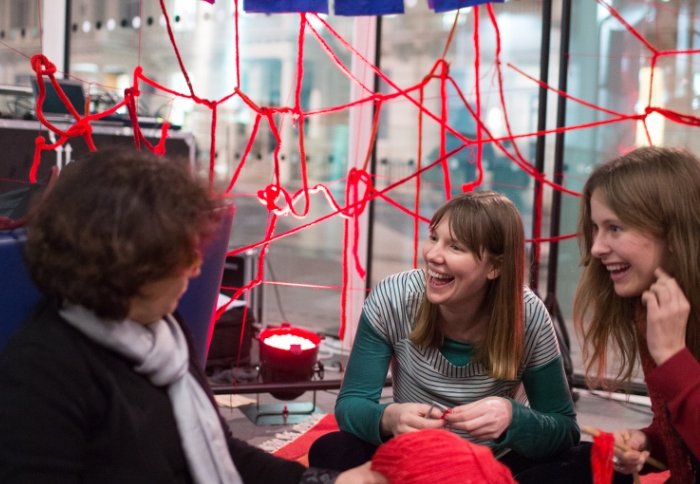

Dr Neil Dufton discusses how knitting and chatting with the public has helped shape his research into blood vessels.
Knitting has enjoyed something of a renaissance in recent years. The relaxed atmosphere it creates between groups of people has made it an effective, if unusual, medium for scientists at Imperial’s National Heart and Lung Institute (NHLI) to engage with members of the general public about their cardiovascular research.
The Blood Lines exhibit has been selected for this year’s Ideas for Life celebration to mark Universities Week 2014 at London’s Natural History Museum (Monday 8 and Tuesday 9 June).
It provides an interactive experience designed to provoke conversations between researchers and visitors, by inviting people to knit blood vessels whilst chatting about research into heart disease. Visitors will also get to meet Wendy Windpipe and her six-foot tall model trachea for advice on knitting technique as well as insights into how blood is transported around the body.
We can’t wait to go to the Natural History Museum – it’s an iconic place to discuss what we’re doing
– Dr Neil Dufton
Research Associate, National Heart and Lung Institute
Participants are invited to pull up a seat or artfully embroidered blood-themed cushion, to choose some wool (red or blue, depending on whether you want to knit an artery or a vein), and to get knitting using a rudimentary knitting machine made from four lollipop sticks and an empty cardboard tube. Before long, the results of the stitching start to grow out of the tube, providing an excuse to talk about angiogenesis – the process by which blood vessels develop inside the body.
Anyone tempted to think of knitting as a sedentary past-time will start to revise their opinions as Blood Lines transforms into a site for animated debate about the latest research into blood vessels, and a giant woolly circulatory system starts to take shape.

The intriguing apparatus that allow participants to knit blood vessels
“Something as physical as knitting gets people sucked in. Because our visitors get to do something hands-on, they’re involved straight away. We’ve had a very good response from all age groups,” says Dr Neil Dufton, NHLI research associate and scientific consultant for Blood Lines. “It’s a very repetitive, therapeutic process. Once you start doing something with your hands, you’re ready to start asking questions about our research.”
Neil works in Dr Anna Randi’s research group based in the NHLI vascular science section. The group is funded by the British Heart Foundation to carry out research into the building of blood vessels, vascular inflammation and von Willebrand disease – a form of haemophilia. Some of their latest work explores the role of the ‘decision-making’ endothelial cells in maintaining healthy blood vessels.
“People often have questions about cardiovascular disease that they are not sure how to approach in a hospital or GP surgery, and this exhibit gives than an opportunity to find out about the latest research in a more relaxed environment,” Neil adds.
"Like appearing at Wembley"
Blood Lines was originally developed for the Green Man Festival in 2013, and has since toured a wide range of public venues and events. Neil enthuses about the experience of taking part in activities at places of historic scientific importance: “Taking Blood Lines to the Science Museum Lates was like appearing at Wembley. We can’t wait to go to the Natural History Museum – it’s an iconic place to discuss what we’re doing.”

Dr Neil Dufton poses with a knitted vein and artery
Neil said: “One of the best things we scientists can learn is how to communicate about our research without hiding behind the jargon. The process is two-way, because the questions from our visitors provide new perspectives and help us think about scientific problems from new points of view.
“Everyone from the group has got involved with Blood Lines. It has been a great leveller and team-building project. It allows us to have conversations about our work in new ways with each other as well as our audiences, providing inspiration for our research back in the labs.”
Blood Lines was developed as part of the NHLI’s programme to develop innovative approaches to public engagement with science, and encourage early career researchers to talk with lay audiences about their research.
Article text (excluding photos or graphics) © Imperial College London.
Photos and graphics subject to third party copyright used with permission or © Imperial College London.
Reporter

Mike Jones
Enterprise

Contact details
Tel: +44 (0)20 7594 3891
Email: michael.jones1@imperial.ac.uk
Show all stories by this author





Leave a comment
Your comment may be published, displaying your name as you provide it, unless you request otherwise. Your contact details will never be published.